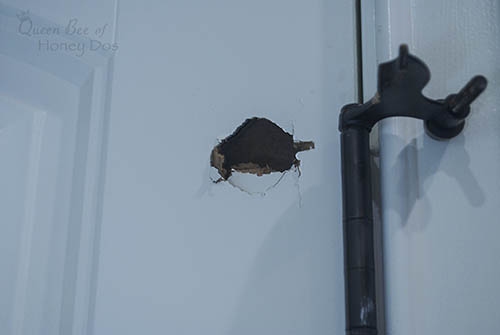Doors are essential to our homes, providing privacy, security, and a barrier from the outside world. However, accidents can happen over time, and holes can appear on our doors. Whether it’s a small hole from a doorknob or a larger hole from an unfortunate mishap, fixing these holes is crucial to maintaining the integrity and aesthetics of your door. In this guide on how to easily fix a hole in a door, I will walk you through the step-by-step process of fixing a hole in a door with ease, providing you with the ultimate solution.
Tools and Materials Needed
Before we dive into fixing a hole in a door, it’s important to gather all the necessary tools and materials. Here’s a list of items you’ll need:
- Wood filler or spackle will patch the hole and create a smooth surface.
- Putty knife: A putty knife is essential for evenly applying the wood filler or spackle.
- Sandpaper: You’ll need sandpaper to smooth the patched area and prep it for painting or staining.
- Primer: If you plan on painting the repaired door, a primer is necessary to ensure proper paint adhesion.
- Paint or stain: Depending on the finish of your door, you’ll need either paint or stain to match the repaired area with the rest of the door.
- Paintbrushes or foam rollers: These will be used to apply the paint or stain.
- Screwdriver: If a loose screw causes the hole, a screwdriver will be needed to tighten it.
Having these tools and materials ready will make the process much smoother and more efficient.
How to Fix a Hole in a Door with Ease
Assessing the Size and Type of Hole
Before you can start fixing the hole in your door, assessing the size and type of hole you’re dealing with is important. This will help you determine the best approach for repairing it.
A simple patching technique will suffice for small holes, such as those left by doorknobs. Medium-sized holes, such as those caused by accidents or hardware removal, may require more work to ensure a seamless repair. Finally, large holes, such as those resulting from a significant impact, may require more extensive repairs, including replacing a portion of the door.
By accurately assessing the size and type of hole, you can proceed confidently, knowing that you have chosen the appropriate repair method.
Patching Small Holes in Doors
Small holes in doors are often caused by doorknobs repeatedly hitting the same spot over time. Fortunately, these holes are relatively easy to repair. Here’s a step-by-step guide:
- Clean the hole thoroughly to remove any loose debris or paint chips before filling it.
- Apply wood filler or spackle: Using a putty knife, apply a small amount of wood filler or spackle to the hole, ensuring it is filled.
- Smooth the surface: Once the filler has dried, use sandpaper to smooth the patched area until it is flush with the rest of the door.
- Prime and paint: If necessary, apply a primer to the patched area, followed by paint that matches the color of your door. Allow it to dry completely.
Following these steps, you can easily patch small holes in your door and restore its appearance.
Repairing Medium-Sized Holes in Doors
Medium-sized holes require more effort to repair but can still be easily fixed. Here’s what you need to do:
- Clean and prepare the hole: Like with small holes, ensure the hole is clean and debris-free.
- Create wooden support: Cut a piece of scrap wood slightly larger than the hole and insert it behind the damaged area. Secure it in place using screws or adhesive.
- Apply wood filler or spackle: Fill the hole with wood filler or spackle, ensuring it covers the wooden support.
- Smooth and sand: Once the filler is dry, sand the patched area until smooth and even with the rest of the door.
- Priming and painting: Apply a primer to the repaired area, followed by paint or stain that matches the door’s finish. Allow it to dry completely.
By following these steps, you can effectively repair medium-sized holes in your door, leaving no trace of the damage.
Fixing Large Holes in Doors
Large holes in doors require a more extensive repair process, but they can be fixed seamlessly with the right approach. Follow these steps:
- Assess the extent of the damage: Determine if the hole can be repaired or if it requires replacing a section of the door.
- Remove damaged area: If necessary, use a saw to carefully remove the damaged section of the door carefully, ensuring you create a clean and even edge.
- Cut a replacement piece: Using the removed section as a template, cut a replacement piece of the same size and shape from a matching wood.
- Attach the replacement piece: Apply wood adhesive to the edges of the replacement piece and carefully insert it into the hole. Secure it with clamps until the adhesive dries.
- Sand and smooth: Once the adhesive has dried, sand the patched area until it is smooth and level with the rest of the door.
- Apply primer, paint, or stain: Finish the repair by applying primer, paint, or stain to match the door’s finish. Allow it to dry completely.
Following these steps, you can successfully fix large holes in your door and restore its functionality and appearance.
Sanding and Preparing the Patched Area
After patching the hole and allowing it to dry, sanding and preparing the patched area is crucial for achieving a seamless repair. Here’s what you need to do:
- Start with coarse-grit sandpaper: Use coarse-grit sandpaper to smooth out any rough edges or uneven surfaces on the patched area.
- Transition to finer-grit sandpaper: Gradually switch to finer-grit sandpaper to achieve a smoother finish. Sand in a circular motion to blend the patch’s edges with the surrounding door surface.
- Wipe clean: After sanding, wipe the patched area with a clean, damp cloth to remove dust or debris.
Properly sanding and preparing the patched area ensures that the repair seamlessly blends with the rest of the door.
Painting or Staining the Repaired Door
Once the patched area is properly sanded and prepared, it’s time to paint or stain the repaired door to match its original finish. Here’s what you need to do:
- Apply primer: If you’re painting the door, apply a primer to the entire surface, including the patched area. This ensures proper adhesion of the paint and helps achieve a uniform finish.
- Paint or stain: Using a brush or foam roller, apply the paint or stain to the door, starting with the patched area. Feather the edges of the paint or stain to blend it seamlessly with the rest of the door.
- Allow it to dry: Follow the manufacturer’s instructions to determine the drying time needed for the paint or stain to cure. Avoid closing the door until it is completely dry.
By carefully painting or staining the repaired door, you can make the patched area virtually indistinguishable from the rest of the door, restoring its beauty and functionality.
Preventing Future Holes in Doors
Now that you have successfully repaired the hole in your door, it’s important to take preventive measures to avoid future damage. Here are some tips:
- Install a doorstop: Installing a doorstop prevents doorknobs from hitting the wall and causing holes.
- Use protective coverings: If you frequently move furniture or heavy objects near doors, consider using protective coverings, such as adhesive rubber bumpers, to prevent accidental damage.
- Tighten loose hardware: Regularly check and tighten loose screws or hardware to prevent them from causing holes over time.
By implementing these preventive measures, you can prolong the lifespan of your doors and avoid the need for future repairs.
My Opinion
Fixing a hole in a door may seem daunting, but it can be accomplished easily with the right tools, materials, and techniques. Remember to assess the size and type of hole before starting the repair process, as this will guide you in choosing the appropriate method. Whether it’s a small hole that requires simple patching or a large hole that necessitates replacing a section of the door, following the step-by-step instructions outlined in this guide will help you achieve a seamless repair.
Ensure the patched area is properly sanded and prepared before painting or staining the door. This will result in a professional-looking finish that blends seamlessly with the rest of the door. Lastly, take preventive measures to avoid future door holes, such as installing doorstops and using protective coverings.
By following these tips and techniques, you can confidently tackle any hole in your door and restore its functionality and beauty.




